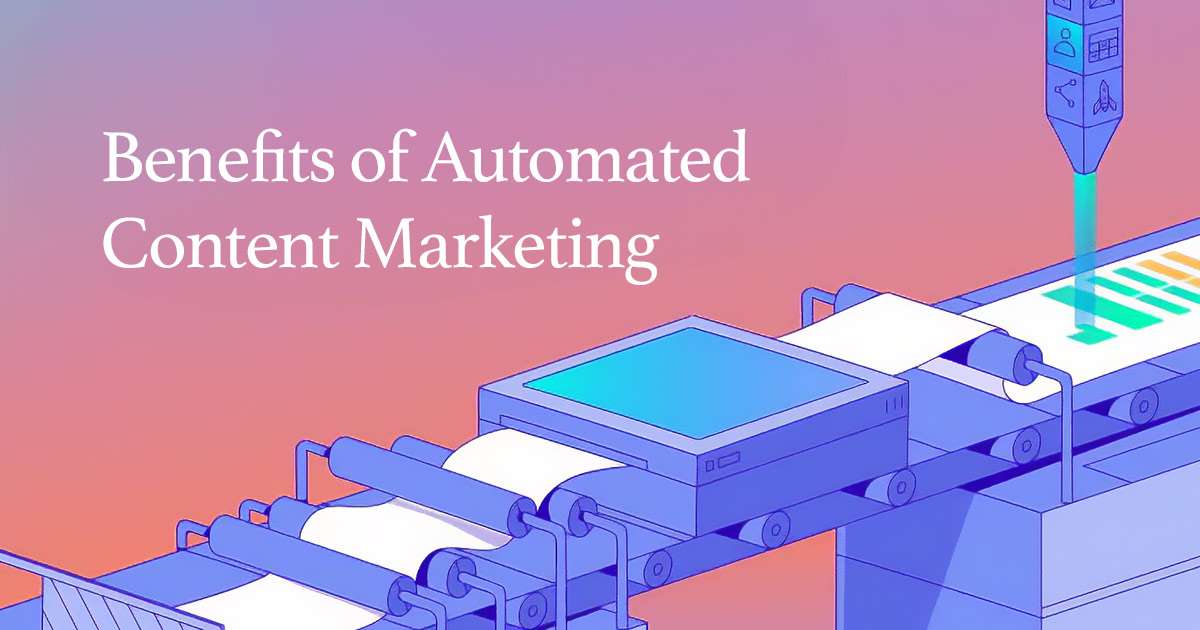What is Content Automation? Benefits of Automated Content Marketing

Content marketing is one of the best ways to advertise and market products and services today. A 2022 study by HubSpot found that businesses focusing on blogging are 13 times more likely to see a good return on investment. This is because content marketing helps build trust, engage audiences, and generate high-quality leads with useful and relevant content.
The main goals of content marketing are to attract and keep a specific audience, drive profitable customer actions, and establish brand authority. These goals are met by consistently delivering high-quality content that meets the needs and interests of your target audience. By providing valuable information and building deeper connections with customers, businesses can increase website traffic, improve customer loyalty, and boost sales.
The Process of Content Marketing
If you think your product or service could benefit from content marketing, it’s important to understand how it works. Knowing the steps involved can help you create an effective strategy.
- Research and Planning: Find out who your target audience is and what they need. Set clear goals for your content, and make a content calendar to stay organized.
- Content Creation: Create engaging and valuable content like blog posts, videos, infographics, and social media updates. Make sure the content matches your audience’s interests.
- Optimization: Use SEO best practices to help your content rank well in search engines and reach more people.
- Distribution: Share your content on different platforms, including your website, social media, email newsletters, and guest blogs.
- Engagement: Interact with your audience by responding to comments and starting discussions. Build a community around your content.
- Analysis and Refinement: Regularly check key performance indicators (KPIs) to see how well your content is doing. Use the data to make improvements.
Skills and People Needed
Content marketing requires a variety of skills and roles.
- Content writers and creators are experts at making interesting and relevant content.
- SEO specialists ensure your content is easy to find on search engines.
- Social media managers share content and engage with the audience on social media.
- Data analysts track content performance and provide insights.
- Graphic designers create eye-catching visuals to support your content.
Understanding these steps and the skills needed can help you build a strong content marketing strategy that delivers results.
Introducing Content Automation
Content marketing can be time-consuming. Creating high-quality content can take several hours to a few days, and optimizing it for search engines and audience needs can add even more time. Overall, the entire process, from start to finish, can take anywhere from a few days to a week.
However, this process can be made much faster with content automation.
What is Content Automation?
Content automation uses technology to streamline, manage, and optimize the creation and distribution of content. This means automating tasks like keyword research, content creation, scheduling, distribution, and measuring performance.
How Content Automation is Done: Key Steps
Content automation makes content marketing faster and easier by streamlining several steps.
- Keyword Research Automation: Tools like SEMrush or Ahrefs automatically find relevant keywords your audience is searching for. They also provide details on keyword difficulty and search volume.
- Content Creation Automation: AI writing tools such as Jasper and ChatGPT can create drafts or even complete pieces based on guidelines and topics you provide. They help produce blog posts, social media updates, emails, and more with little manual effort.
- Content Optimization Automation: Tools like SurferSEO compare your content to top-ranking articles and suggest improvements. They recommend keyword usage, content structure, and readability enhancements to boost SEO.
- Content Scheduling and Distribution Automation: Platforms like Hootsuite or Buffer can automatically schedule and post content across multiple social media channels. Email marketing tools like Mailchimp automate sending newsletters and targeted email campaigns.
- Performance Tracking and Reporting Automation: Google Analytics and similar tools automatically track key metrics such as page views, time on site, and conversion rates. These tools generate reports to help you understand what’s working and where improvements are needed.
The Benefits of Content Automation for Faster Workflows
Incorporating content automation into your marketing strategy can significantly enhance the speed and efficiency of your workflows. By automating repetitive and time-consuming tasks, your team can focus on more crucial activities, leading to quicker content creation and distribution.
- Increased Speed: Automating tasks like keyword research, content creation, and distribution saves time. This speeds up the entire process, allowing you to publish content more often and keep up with trends.
- Consistency and Quality: Automated tools help maintain a consistent style, tone, and quality in all your content. This strengthens your brand and reduces mistakes.
- Improved Productivity: With automation handling routine tasks, your team can focus on creative and strategic work. This makes everyone more productive and lets you produce more high-quality content without adding extra work.
- Scalability: As your business grows, automation allows you to increase your content efforts without needing more people or spending more money. You can easily meet higher demands and reach more people.
- Data-Driven Insights: Automated tools provide useful information about how your content is performing. This helps you make better decisions and improve your strategies for better results, leading to more successful campaigns and a higher return on investment (ROI).
By leveraging content automation, you can transform your content marketing process, save time, boost productivity, and achieve better results.

